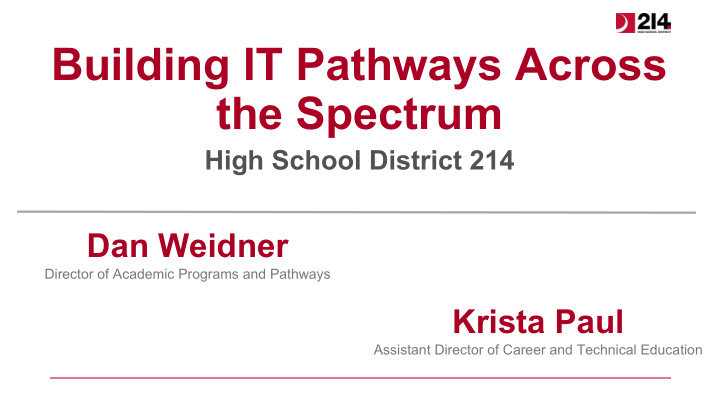



Building IT Pathways Across the Spectrum High School District 214 Dan Weidner Director of Academic Programs and Pathways Krista Paul Assistant Director of Career and Technical Education
Career Pathways Theory of Action High School District 214
Career Pathways High School Re-envisioned - Career Programs of Study Engagement through Relevance: Guiding Principles 1. Sequence of courses that lead beyond high school 2. Workplace learning experience that provides students with real-world understanding of career areas through internships or problem-based learning experience 3. Opportunity to earn career certification/college credit
Pathway Development Process High School District 214 A systematic approach of engagements, development, and deployment efforts allows for replicable and scalable career pathway efforts. 1. Advisory Team 2. Research & Evaluation 3. Pathway Development 4. Implementation & Funding 5. Redefine High School Workplace Learning
Pathway Development Process Advisory Team ➔ Bring together representative IT Pathway Efforts team of district, building, Critical issues seeking feedback post-secondary education, and ● How do we best develop relevance and industry/community leaders engagement? ● What does the IT career pathway look like for the next generation of careers? ➔ Gauge interest and support ● What are key sectors? ➔ Develop broad buy-in Limited initial capacity of support ● Tapped into state-wide discussions ➔ Discuss scalability ● Alumni and personal connections ● Utilized in house professionals
Pathway Development Process Research and Evaluation ➔ Review job outlook IT Pathway Efforts ➔ ID existing program models Job Outlook - High Wage/High Need ➔ ID college course/degree offerings and ● Bureau of Labor Statistics required teacher credentialing ● H-1B Visas (DOL Youth CareerConnect ➔ Identify potential certifications grant) ➔ ● STEM Learning Exchanges Research external experiences and workplace learning opportunities Teacher Capacity/PD needs (2013-14) ➔ Identify resources needed, budgets, external funding sources ● 6 business education instructors with computer science teaching experience ➔ Identify teacher capacity and district-wide professional development needs ● 2 computer science courses, 2 ➔ Identify success metrics networking courses
Pathway Development Process Pathway Development ➔ Identify potential courses IT Pathway Efforts ➔ Develop new course proposals ● Created a 4-year IT career pathway plan ➔ Share DRAFT course sequence with with development, pilot, and deployment stakeholders time periods identified ➔ Identify extensions to the classroom ● In- and out-of-district professional (summer, co-curricular, field trips) development opportunities for existing ➔ Develop bridges between secondary and and new IT instructors post-secondary opportunities ○ Mobile Makers ➔ Engage in curriculum ○ AP workshops development ○ Graduate coursework ➔ Teacher professional ○ In-district curriculum and planning development ● Industry connections and workplace ➔ learning development Partner with industry for potential workplace learning opportunities
Pathway Development Process Implementation & Funding ➔ Develop teacher led advisory IT Pathway Efforts team ● Career Pathway Teacher Lead Model and ➔ External partner engagement Advisories ➔ Determine sustainability of district support ● Cybersecurity Working Group ➔ Pursue supplemental funding sources ➔ Development and support of external experiences and workplace learning ● Counselor and Teacher Career Pathways opportunities Internal University ➔ Develop internal and external ● Career Pathway Marketing Materials marketing materials ● Targeted messaging based upon career ➔ Collect data according to pathway metrics cluster identification ➔ Identify opportunities to scale ➔ Review and modify as needed
Pathway Development Process Refine High School Workplace Learning ➔ ➔ Student internship and workplace learning Employer partners with a Career experiences primarily provided after junior Discovery Advisor assigned to his/her through senior year cluster ➔ ➔ Students with transition services may Employer provides an internship extend this timeline through age 22 experience in one of two ways: ➔ Students are individually placed with ○ Micro-internship: Project-based 1–3 employers based on interest and weeks in duration preparation in program of study ○ Traditional: Semester long ➔ Students with disabilities begin simulated experience 6–16 weeks in duration workplace experiences at school site and ➔ Internally develop and expand progress through tiered levels of modified opportunities through on site micro support depending on need businesses
Pathway Development Process Refine High School Workplace Learning A shift to ONE common vision Career readiness services, programs and events designed to support → Old Model - 2 Departments/2 Associate students’ career development. Superintendents ○ Teaching and Learning Assistant Director of CTE ■ CTE, Elective Academics, CTE Programs Supervisor Traditional Internships • Building/School Based Career Advisors (6) ○ Student Services • Community Based Career Advisors (2) ■ Counseling, SpEd, Vocational Placements, Transition Plans Vocational Programs Supervisor → • Vocational Evaluation Coordinator (1) New Model - 1 Department/1 Associate • Job Placement Specialists (5) Superintendent ○ Coordinates entire student academic • On-site Job Coaches (11) experience • Discover IT Advisors (4 - Federal DEI IT Grant) ○ Center for Career Discovery created from SPED and Gen Ed resources
Center for Career Discovery Refine High School Workplace Learning Program Highlights •950+ Industry Partners •2,750 workplace learning experiences (2016-17) • Combination of embedded and external learning experiences Flash Talk on Center for Career Discovery - Wednesday @ 10:30am
D214 IT Career Pathways Programs of Study and Enrollment Trends • 20+ College Credit Hours • 4 Industry Credentials • Internship Experience
Recommend
More recommend